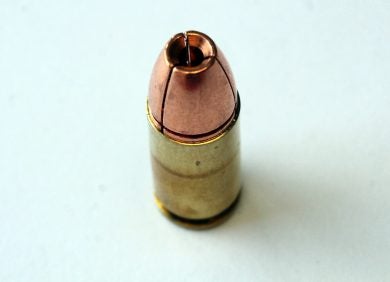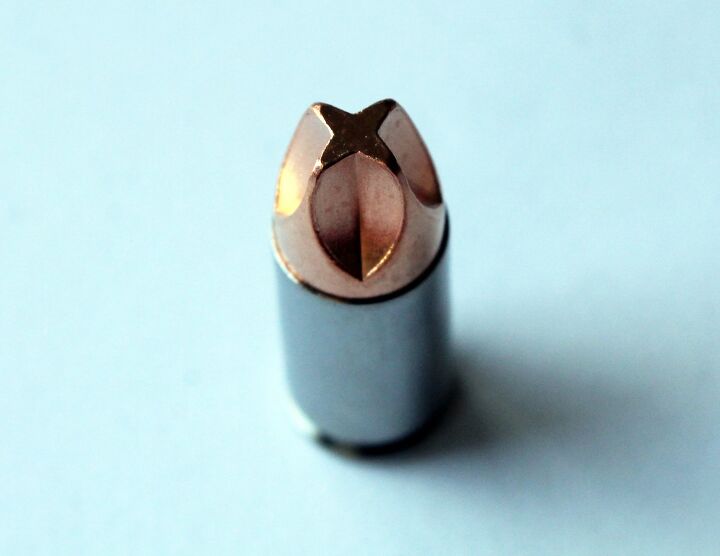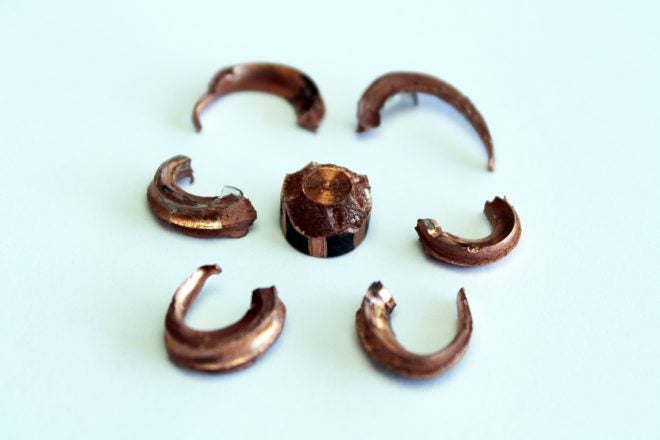Lehigh has a well-deserved reputation for making gimmick ammunition. Their Controlled Fracturing Hollow Point pistol ammunition does perform as advertised insofar as it fractures, but fragmentation in a pistol round is not a desirable feature. Fragmentation can be useful in rifle rounds because the impact velocity is fast enough that it pushes tissue apart so quickly that the size of the temporary wound cavity exceeds the elastic limit of tissue and it begins to tear. Fragments improve this tearing, causing more permanent extensive damage than rifle rounds at similar velocity that do not fragment. Pistol bullets lack the speed necessary for temporary stretch cavity to contribute to wounding so fragments that are produced by pistol bullets just result in relatively small wounds that don’t cause as much bleeding as a larger, wider main track.

Underwood loaded 9mm Lehigh Controlled Fracturing Hollow Point.
 Lehigh’s Extreme Defender line relies on some sort of fictional fluid dynamic magic that seems to be related to enchanted faerie flutes. While much ado has been made of it, there really is no indication that it performs any better than full metal jacket bullets of similar weight. The claims about the wounding potential are based on the appearance in gel, which does seem to be impressive. But ballistic gelatin is not intended to simulate the appearance of a wound, it is only intended to produce measurements that correlate strongly with human tissue. The dramatic appearance is simply a result of a relatively fast pistol bullet. The faster bullet creates a larger stretch cavity and the gel tears more readily than real tissue, but these bullets are nowhere near fast enough to cause real injury via the temporary stretch cavity. To be perfectly frank, a fair argument could be made that FMJ actually tends to cause slightly more severe wounds because it cuts a wider path as it travels sideways for a short distance.
Lehigh’s Extreme Defender line relies on some sort of fictional fluid dynamic magic that seems to be related to enchanted faerie flutes. While much ado has been made of it, there really is no indication that it performs any better than full metal jacket bullets of similar weight. The claims about the wounding potential are based on the appearance in gel, which does seem to be impressive. But ballistic gelatin is not intended to simulate the appearance of a wound, it is only intended to produce measurements that correlate strongly with human tissue. The dramatic appearance is simply a result of a relatively fast pistol bullet. The faster bullet creates a larger stretch cavity and the gel tears more readily than real tissue, but these bullets are nowhere near fast enough to cause real injury via the temporary stretch cavity. To be perfectly frank, a fair argument could be made that FMJ actually tends to cause slightly more severe wounds because it cuts a wider path as it travels sideways for a short distance.
Despite its dramatic name, Lehigh’s Controlled Chaos rifle ammunition seems to be less of a gimmick, though. At least in the .300 AAC flavor.
115 gr may seem on the light side for a .30 caliber bullet if you’re accustomed to .308 Win and other “real” rifle cartridges, but 110-115 gr projectiles are just about perfect for .300 BLK because they allow suitable velocities. In this test, the projectile performed exactly as the manufacturer claims, producing rather impressive data points, as seen below.
Impact velocity: 2,146 fps
Penetration: 19″
Neck: 1.75″
Retained weight: 43.1 gr
Average petal weight: 12.9 gr
Let’s unpack those numbers. If this were a heavy open tip match. in .223 Rem made by a more established company like the Sierra 77 gr Match King, the 1.75″ neck, impressive temporary cavity, and decent penetration with 43 gr of retained weight would be considered to be fantastic performance. The fragments produced penetrated surprisingly deep in their own right and came well away from the primary wound track.
By all objective, empirical standards, this is excellent performance. To be sure, the load was not tested against barriers, but heavy OTM does not tend to do well against barriers, either, yet it is still commonly recommended for home defense, assuming the home owner doesn’t care much about barrier performance. In some quantifiable ways this load actually performs better than a heavy OTM in .223 Rem. Namely, the size of the fragments and core are substantially larger. To be sure, the numerous tiny fragments produced by large match bullets can initiate innumerable tears, but the larger fragments seen here were able to penetrate more deeply and deviate farther from the primary track than is typically seen in wounds caused by fragmenting rifle ammunition. The core is larger and heavier than that seen from heavy OTM, too.
So why does it still leave a bad taste in our mouth? One reason is cost. Price shouldn’t be the foremost factor when considering ammunition for defense, but if you can get the same performance at lower cost, that lets you shoot more of that ammo to verify reliable function and zero. Depending on which factors you favor, Barnes 110 gr TAC-TX and Hornady 110 gr VMAX both perform at least as well, if not better than this Controlled Chaos load, but cost substantially less. Then there is the problem of integrity. Can you trust a company that sells snake oil, even if the product in question seems to perform well? It seems unlikely they would intentionally foul anything up, but if you have the opportunity to buy from a company that holds government contracts, that may instill more confidence.
Ultimately, I wouldn’t steer anyone away from this particular load. It meets standards and would be useful for defense. Is it the best? Not exactly, but it is certainly better than FMJ. I would advise anyone who is trying to find the “best” load for defense that training matters a great deal more than gear. While it is important to choose effective ammunition, the factors that are most likely to decide whether you survive a really awful day are your will to fight and your training.
Addendum:
This article has provoked a rather emotional response from Lehigh fans. It’s understandable, given the advertising that Lehigh has invested in and the common misinterpretation of gel results. But the claims about fluid dynamic effects are entirely unsupported at the velocities seen from these pistol bullets. In the case of pistol ammunition, the only way to increase the size of a wound is to increase the diameter of the bullet. If you’re interested in getting your bullet nerd on, please read this article: http://gundata.org/images/fbi-handgun-ballistics.pdf I’m certainly no expert and I don’t claim to be. I can only relay to you the findings of actual experts and apply them to these specific cases. If you, dear reader (or Leghigh) believe yourself to be more knowledgeable than the FBI in this matter, I’ll admit that you are far more qualified to have an opinion on the subject than I am.
 Your Privacy Choices
Your Privacy Choices
